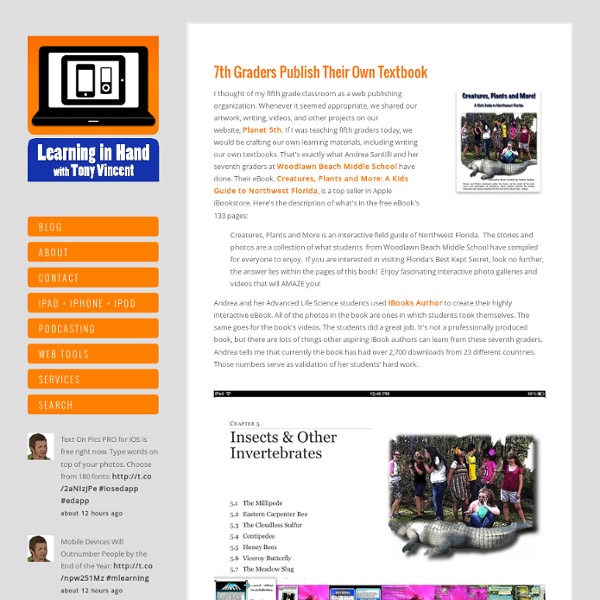7th Graders Publish Their Own Textbook
Mac Life wrote an article titled Super 7th Graders Publish Their Own eBook to the iBookstore. It explains the project in more detail. "Each student has to choose an organisms they wanted to study and were required to submit their topic for approval. Afterward, students had to write informative – but entertaining! – articles about their organism." Andrea collected work from 69 students and entered it into iBooks Author. iBooks Author is free but only works on Macs running 10.7 Lion or higher. iBooks Author is a fantastically powerful tool. There are some disadvantages to using iBooks author for crafting your own learning materials. Check out what Andrea and her students say about writing their book. I think the comment by CNEBBY in the Customer Reviews of Creatures, Plants and More sums up the project well: "This is an awesome example of what kids can do when they are properly motivated by a skilled teacher."
5 Phrases That Can Boost Employee Morale
I left the company years ago for another but I still run into former colleagues. Usually the ensuing conversation involves something along the lines of, “Hey, did you hear about the (latest management decision I think is really stupid) at the plant?” This question was different. “You worked there for almost 20 years,” my ex-coworker said. “Is there anything you wish you could go back and do over?" I thought about it later. Instead I most regret the things I didn't say: To employees who reported to me, to some of my peers, and to at least one person I worked for. It's too late for me, but it’s not too late for you. “That was great how you...” Feel free to go back in time. “Can you help me...?” Even though I could tell he really wanted to participate, I never let him. Asking someone for help implicitly recognizes their skills and value. And there’s a bonus: You get help. “I'm sorry I didn't...” Say you're sorry. Say you're sorry, say why you're sorry, and take all the blame.
My new unplugged coursebook series: Windows
Windows is a coursebook concept drawing on potentially ambiguous pictures as a starting point for unplugged language teaching. Well, as you might expect from any quality coursebook production, my new series Windows was a long time in the making... a whole morning in fact. The first "level (?)" Here is a quick preview of some of the content in the book: But before I refer you to the downloads, an important correction to what I've already typed is in order... It's only "my" series insofar as I've given it a name (and a "level (?)" Even better, distribute the Word file to your learners and have them pick, choose, edit and adapt as they please (this would be the most genuine approach to making it a truly unplugged coursebook!). You won't see any unit or page numbers in the book. Oh, and I'm also already working on the second and third "levels (?)" Anyway, hope you enjoy Windows Level (?) Okay, here come the downloads. Download "Windows - Some Won" - by Jason Renshaw [PDF Version] [Late edit!]
Languages - Quick Fix - Essential phrases in 40 languages
How to Create Your Own Textbook — With or Without Apple
By Dolores Gende Apple’s iBooks2 and authoring app has created big waves in education circles. But smart educators don’t necessarily need Apple’s slick devices and software to create their own books. How educators think of content curation in the classroom is enough to change their reliance on print textbooks. As the open education movement continues to grow and become an even more rich trove of resources, teachers can use the content to make their own interactive textbooks. Here’s how to create a digital textbook and strategies for involving the students in its development in three steps. 1. Teachers can work with colleagues within their subject area departments and beyond the walls of the classroom to aggregate resources through social bookmarking. Also try Paper.li or The Twitted Times, which will sift through your connections’ resources and organize them. 2. One of the most user-friendly tools to post resources for your course is LiveBinders. 3. Cybrary Man Educational Resources
About Us
Wattpad is the world's largest community of readers and writers Stories to read Wattpadders and growing Minutes spent on Wattpad every month Mobile, across all devices Storytelling Redefined Wattpad is a place to discover and share stories: a social platform that connects people through words. It is a community that spans borders, interests, languages. Find Any Story, Write Any Story With thousands of stories added each day, there’s always something you want to read. Free Reading, not eReading Wattpad stories are free. Stories Made Social Join the conversation about the stories you read: message the writer and interact with other people who love the story as much as you. Live Story Updates Get notified the moment your favorite writer shares a new chapter. Company Wattpad is proudly based in Toronto.
Related:
Related:



